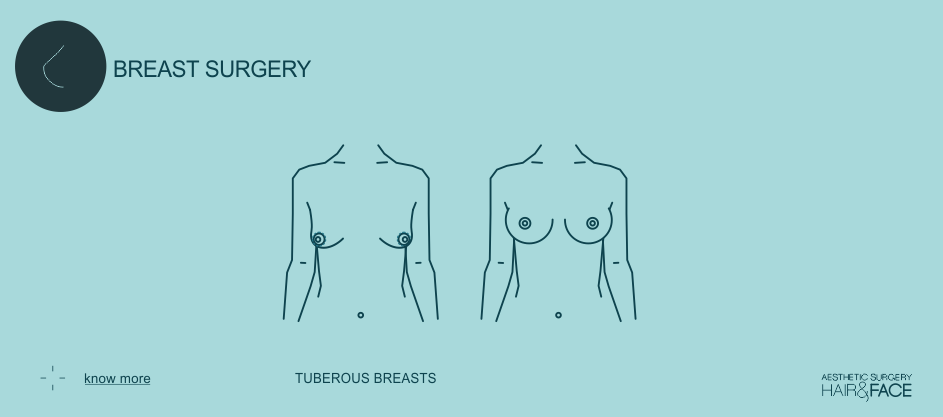The kind of breast called tuberous is caused by an abnormality produced to stop normal development which results in narrow characteristics and an inframammary fold which starts very lateral.
The procedure
When the diameter of the areola is big and sticks out, a periareolar excision is needed for the excess skin, in addition to the positioning of the implant and eliminating the periareolar ring causing the herniation of the gland within the inner region of the breast.
The intervention lasts 2hours
The anaesthetic can be local with sedation or general. In both cases, it is administered by an anaesthetist.
Admission at the clinic is 12hours.
Post operation
There will be inflammation during post-operation.
The pain is a little sharp when the implant stays retropectoral
No brusque movements, neither lifting nor doing any effort.
Shower in 48 hours
Back to work in 5 to 7 days.
The implants are permanent; there is no need to change them.

They are narrow and have an infer-mammary fold which starts very lateral.
The infra-mammary fold is an important anatomical focal point from an anatomical and surgical standpoint, because it marks the inferior extension of the mammary parenchyma and the start of the abdomen.
The tightness of this fold is variable and in some cases, it can produce less natural breasts and frequent asymmetries.
As the breast´s fold becomes tight and high and the distance from the areola and the fold is shortened, a constricted appearance is developed, as if the gland wants to make way through the areola.
Many asymmetric breasts are related to a uni or bilateral contraction. When this condition is accompanied with mammary hypoplasty, a modification, repositioning and extension of the infra-mammary folds should be scheduled in order for them to be symmetric.
The shortage in the lower area should also be restored.
When the diameter of the areola is big and sticks out, a periareolar excision is needed for the excess skin, in addition to the positioning of the implant and eliminating the periareolar ring causing the herniation of the gland within the inner region of the breast.
The final results of surgical correction of the tuberous breast are far from ideal. There is scarring and some residual abnormality persists.
The implants can contract and become noticeable through the skin.
All these limitations are carefully explained in the consultation.
The type of anesthetic used varies between local anesthetic with sedation or general anesthetic. An anesthetist is always present for both occasions.
The choice will depend on the surgeon who will assess the patient´s wishes and expectations.
All surgical procedures run inherent risks which include haemorrhage and infection.
The haematoma occurs in 1.5% of all cases.
Infection has an incidence rate of 2.2%
Nerve damage in 5% of all cases
Retracted capsula contracture varies between 6 and 10%.
